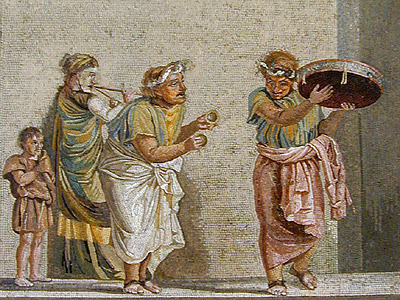
tibicen

The tibicen was the
musician
who played the tibia, a double pipe. Double-reed wind instruments appear
in images from Mesopotamia as early as 3,000 BC. The flute was the first wind
instrument used by the
Egyptians
and the one most commonly used by the
Greeks,
Etruscans,
and Romans (see
Musica
Romana). The Greeks attributed its invention to
Pan, the god of
flocks and shepherds, who found the reed, its earliest material, abundant in
the fields; ancient pipes have been found in a variety of materials (bone,
ivory, and metal) and
styles
(e.g., the aulos was a single
hollow reed which became popular as a double pipe), each instrument producing a
distinctive sound. The
most popular of the wind instruments was the tibia, which consisted of
two pipes, each with a mouthpiece at the top and holes pierced in the stems,
and was played with two hands. It was used in religious ceremonies, rituals and
the theatre (the comedies of Terence were accompanied by pipes of several
kinds).
Umbricius is no doubt making reference to imported flute-girls,
popular entertainers at parties who arrived in Rome from the 2nd century BCE in
the wake of military campaigns in the East.